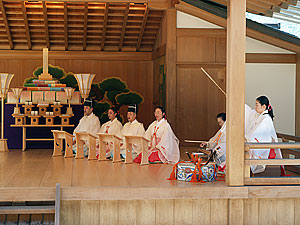
By Bill Roberts
Bill Roberts, a writer who is spending a year at Oomoto, delivered the following speech to the Nagoya branch following its monthly service on Feb. 20, 2005.
Konichiwa. Bill Roberts des. Yoroshiku. Onegaishimasu.
It is an honor to speak today at your tsukinamisai. Nagoya is the ninth Oomoto branch I have visited and the sixth branch to ask me to speak.
As you might know, the Oomoto Foundation has commissioned me to write a book about Oomoto in English for non-Japanese readers, especially the artists, interfaith activists and peace seekers who are increasingly attracted to Oomoto.
One thing I hope to do in this book is to describe the activities and commitment of Oomoto followers in the local branches. Just like people, each branch has its own personality. But the common characteristic is the commitment to Oomoto’s teachings.
During my travels in Japan over the past six years, I have found that Oomoto followers everywhere, from Hokkaido to Nagasaki, from Tottori to Tokushima, are, in the words of Hidemaru Deguchi, in search of meaning.
I mention Hidemaru because I recently read his book. Now that I have read it, I understand why some Oomoto followers, especially young people, tell me “In Search of Meaning” was a major reason they were attracted to Oomoto.
Although “In Search of Meaning” was compiled from the diaries of a Japanese man in his 20s who was writing 80 years ago, the young Hidemaru’s observations on life and spirit are universal in appeal, wise beyond his years, and as pertinent today as they were when he wrote them.
He offers a practical approach to living a spiritual life in a chaotic, material world. “Neither spirit nor matter can exist independently of the other,” he advised.
Hidemaru also wrote: “Only to the extent you put your heart into an effort and become involved can you broaden yourself.” Everywhere I go, I meet Oomoto followers who put their hearts into their spiritual practice on a daily basis.
My own search for meaning brings me back to Oomoto year after year to work on various writing projects, including the book I am now authoring.
I agree with Hidemaru when he says, “a human being must constantly be creating something.” My own need to create led me to become a writer and keeps me on this path.
I first visited Oomoto in the spring of 1999 with my ceramics teacher, Coeleen Kiebert. Coeleen attended Oomoto’s traditional Japanese arts seminar in 1985.
In five of the past six years, Coeleen has brought groups of her adult students to Oomoto to study the traditional Japanese arts. I came with her in 1999, 2000 and 2001.
When I was here for the third time, in the spring of 2001, Masato Deguchi, who was head of the International Department at the time, asked if I could return for an extended visit to work on various English editorial projects.
So I came as a volunteer at the end of 2001 and again in 2002 and 2003. Each time I wrote stories and took photographs, which can be found on the English portion of the Oomoto home page. Now I am here for a year writing this book.
On the home page and in this book the idea is the same: To tell non-Japanese about Oomoto.
I gladly come to Japan to help Oomoto with these projects for many reasons but I would like to talk briefly about two of them, which are related to the teachings of Hidemaru.
First, I believe that if you have a God-given talent then you should use that talent not only to earn a living but to help others. This is especially true for artists and writers, who I believe have a sacred responsibility to use their craft for some greater good.
Let me give you one example of this.
In 1989, the part of California where I live suffered a major destructive earthquake. The epicenter was near Santa Cruz, where my teacher Coeleen lives.
Coeleen organized local artists to go into the schools and guide children to draw and paint about their experience of the earthquake as a way to bring their fears and other feelings to the surface.
This is what I mean about using your talent not only to make a living but also for a greater good.
In the Foreword to “In Search of Meaning,” Hidemaru wrote: “In the very fact that I have been granted life on earth in this manner and moment, I have no doubt that I have some sort of task to complete here. By no means am I here to attain worldly glory and perform brilliant exploits. I believe that one way or another…I must leave behind some mark of my existence for later generations.”
These words ring true for the writer in me. I am grateful that I can use my writing skills to help Oomoto and a couple of non-profit organizations I work with at home. In this small way I hope I can give back to society what God has so freely given to me.
Professionally, I work as a freelance journalist in Silicon Valley, California, where I write about technology and business for various magazines. I also write poetry and fiction but journalism pays the bills.
I am grateful for my craft. In my daily morning prayer, I thank the God of my understanding for allowing me to earn a living as a writer and I ask God’s help in directing that talent to some greater good.
Hidemaru was emphatic about the importance of gratitude and prayer. He wrote: “Being grateful and joyful at all times is the essence of faith.” And he said: “There is no religious life without gratitude and prayer.”
Another reason I undertake these assignments is that I believe Oomoto has an important message for a world in which religious, racial and cultural intolerance are at the root of most problems.
Oomoto’s message of tolerance is essential as our world becomes more interdependent and complicated. One of Oomoto’s central teachings is that all religions come from the same origin. To me, this is the essence of tolerance.
On this matter, Hidemaru said: “If one truly believes in God one must have a sense of love and respect for everything. However, in this world there are those who take their own religion as the only true faith, and refuse to admit others. There are even extremists who reject other faiths as being heretical. This is a grievous misunderstanding, since it is only natural that religions and denominations vary according to time, place, circumstance, and individual.”
Hidemaru wrote those words 80 years ago but they seem entirely relevant today.
Today, there are Muslim fanatics who believe it is their mission to make this world an Islamic planet. And you find ultra-orthodox Jews in Israel who won’t even talk to the Palestinians because they don’t believe Palestine exists.
Even in my own country, America, which was founded on the principle of religious freedom, a growing number of fundamentalist Christians believe their interpretation of God should become the law of the land in the United States.
Such religious bigotry has bedeviled the human race since time began.
Hidemaru’s explanation for this problem is itself timeless: “The world has lost sight of the central point that the universe is created and nurtured by God, and has descended into narrow-minded religion based only on human intellect.”
In closing, I want to tell you a story, which illustrates one of Hidemaru’s themes.
After my first trip to Oomoto I learned that when Japanese look at the full moon they see a rabbit.
Americans do not see a rabbit. They see the face of a man in the moon.
When I heard that the Japanese see a rabbit, I could hardly wait for the next full moon. When it came, I searched and searched for the rabbit.
Finally, I saw the rabbit, but only after I was willing to let go of my American man-in-the-moon perception. The next time you look at the full moon, let go of your rabbit perception and see if you can find the man.
My point is this: If people can look at the moon and see different things, then their concept of God, which is infinitely more complicated than a full moon, are certainly going to differ across time, place and culture.
Hidemaru knew this better than anyone. He wrote: “God is one, but depending on the manner of preaching and the person doing the preaching, he [God] has many different manifestations.”
To me, those words mean we all actually pray to the same higher power of the universe, even though we may have very different concepts of God.
I think this is one of the key messages of Hidemaru and Oomoto. And I hope it is one of the messages of my book.
Kyo-wa watashino hanashi-o. O-kiki kudasari. Arrigato gozaimashta.
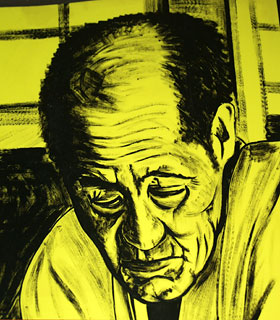 A sketch of Hidemaru Deguchi, rendered by Oomoto follower Yoshinori Ito, is displayed in the Nagoya branch.
A sketch of Hidemaru Deguchi, rendered by Oomoto follower Yoshinori Ito, is displayed in the Nagoya branch.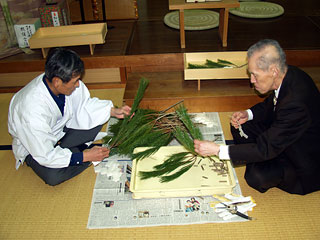 The day before the tsukinamisai (monthly service) members of the Nagoya branch are busy with preparations. Matsuo Ishihara, the branch chief (at left), and Terukage Miwa prepare pine boughs for the offering.
The day before the tsukinamisai (monthly service) members of the Nagoya branch are busy with preparations. Matsuo Ishihara, the branch chief (at left), and Terukage Miwa prepare pine boughs for the offering.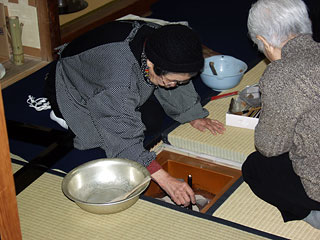 Two women clean the tea room.
Two women clean the tea room.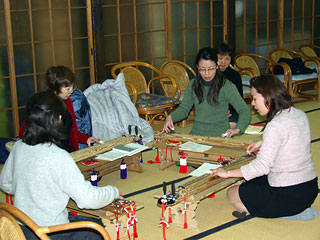 The koto players practice.
The koto players practice.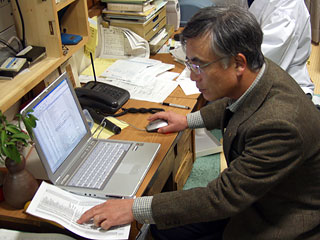 Yoshio Hori, the deputy branch chief, prepares a multimedia presentation that will be used.
Yoshio Hori, the deputy branch chief, prepares a multimedia presentation that will be used. The priests rehearse.
The priests rehearse.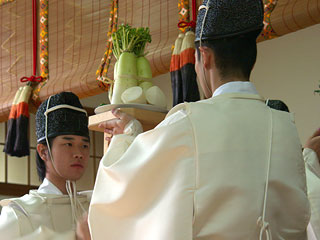 It all pays off on the day of the monthly service. These two priests are Yoshio Hori’s sons.
It all pays off on the day of the monthly service. These two priests are Yoshio Hori’s sons.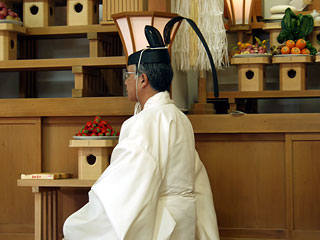 Yoshio Hori serves as chief priest.
Yoshio Hori serves as chief priest.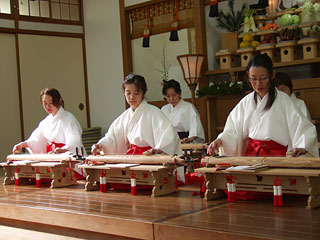 The koto players offer a special song for a visitor.
The koto players offer a special song for a visitor.New Contents Thu, May 20, 2010
- Oomoto participates in Sant’Egidio conference : Dialogue among religions and cultures : On divided island nation of Cyprus By Bill Roberts
- Photo Album : Portraits of three branches: Shoko, Tanegashima and Aomori By Bill Roberts
- Oomoto FAQ
- A Letter from Oomoto : Of mountains and myths By Bill Roberts
- Polyglot poem festival The Utamasturi is going international — what’s next? By Bill Roberts
- Ethics education program captures the spirit of Bankyo Dokon By Bill Roberts
- A Letter from Oomoto : A year’s worth of adventure in a summer of branch visits By Bill Roberts
- In Kumamoto, it’s all about water – and fire By Bill Roberts
- A speech by Nevada Taylor at the Kii Branch in Wakayama Prefecture on April 13, 2008.:An Encounter With Oomoto Through Aikido
- Utamatsuri, Poem Festival, in Tokyo(on April 17, 2008)
- A speech by Neil Ryan Walsh at the Kobe branch on Mar. 9th, 2008.:Planting the Seeds of the Soul
- Meeting with the Fifth Spiritual Leader of Oomoto, Madame Kurenai Deguchi by Neil Ryan Walsh
- A speech by Neil Ryan Walsh at the Nagoya branch on Feb. 17th, 2008.:The Japanese Arts beyond National Boundaries
- To the Oomoto branch in Nagoya: City of Eel and Toyota by Neil Ryan Walsh
- A Speech by Nissim Ben Shitrit, Ambassador of Israel on the occasion of the Oomoto Setsubun Grand Festival in Ayabe February 3rd, 2008 : Japan and Israel : Two Lands Balancing the Needs of Traditional Culture and Modern Life. r
- A permanent memorial to Onisaburo (A Speech at the Autumn Grand Festival , November 6, 2007 : )By James Parks Morton, Founder and Chair, Emeritus of The Interfaith Center of New York
- Israel, Palestine and the Power of Poetry(Oomoto believes small efforts can have lasting ripple effects on people and peace)By Bill Roberts
- “Something Great”(This genetics pioneer, a friend of Oomoto, offers a clue to the mystery of life)By Bill Roberts
- Kamishima Cleanup (Harima branch members regularly visit this sacred island to keep the shrine tidy)By Bill Roberts
- Kyotaro Deguchi was one of six recipients of the 2007 James Parks Morton Interfaith Award
What is Oomoto?
- What is Oomoto?
- Spirtual Centers
- Founders and Spiritual Leaders
- History
- Organization and activities
- Teachings and scriptures
- Art Works of Founders and Leaders
Opinions[Archive]
- Statement of regret for the outbreak of war against Iraq (March 20,2003)
- Jinrui Aizenkai dispatched the "Urgent Appeal for a World (Global) Crisis" on March 14.
Grappling with Bioethics[Archive]
- Oomoto’s support for abolishing the death penalty (12, June 2003)
- The Oomoto Foundation protests any birth of a human clone baby. (5, January 2003)
- OOMOTO'S VIEW REGARDING JAPAN’S PERMITION TO THE RESERCH OF HUMAN EMBRYONIC STEM CELLS (ES cells)(12, June 2000)
Vistor’s Review[Archive]
- A speech by Bill Roberts at the Oomoto branch in Hiroshima after its monthly service on March 18, 2007:Encounters with war and peace
- How Bankyo Dokon changed one life by Linda Macphee
- A speech by Bill Roberts at the Hokuriku (Kanazawa) branch on Dec. 3, 2006:Ritual and myth -an encounter with ‘divine madness’
- A speech by Bill Roberts at the Himeji Cultural Center on Feb. 25, 2007:Mesmerized by the Japanese Arts
- A speech by Bill Roberts at the Kobe branch on Feb. 11th, 2007.:There are just human tears and human joy
- A Speech on the occasion of the Oomoto Setsubun Grand Festival in Ayabe February 3rd, 2007 : Egypt's role in Middle East peace
- Keynote Speech for the 28th World Federation Japanese Religionists Conference for World Peace in Tokyo (at Kokugakuin University, Novermber 29, 2006):Vision for Peace in the Middle East By Dr. Munther S. Dajani, Professor Dean, Faculty of Arts, Al Quds University, Jerusalem
- A speech to the Kyoto branch:Spiritual adventures in researching Oomoto leaders
- A Speech at The Oomoto Foundation on Monday, November 6, 2006 : Jordan's role in Middle East By Samir Nouri, Ambassador of the Hashemite Kingdom of Jordan
- A letter from Oomoto:The Young People of Tottori
- A speech by Bill Roberts on the occasion of the dedication ceremony for the new shrine of Tottori Branch By Bill Roberts Oct. 8, 2006
- A speech by Bill Roberts at the Oomoto branch in Hiroshima after its monthly service on March 18, 2007:Encounters with war and peace
- How Bankyo Dokon changed one life by Linda Macphee
- A speech at Setsubun : A Portrait of Oomoto By Bill Roberts Feb. 3, 2006
- New Publication ! By Bill Roberts Feb. 3, 2006 A Portrait of Oomoto
you can read this book in html => http://www.jinruiaizenkai.jp/English/en-kolumno/en-bill/en-sugao/billbook1en.html
E-mail below to order brobert1@ix.netcom.com
Current Topics
- Prayer Offering and World Religious Forum II
- Living the art of dialogue
- Kyotaro Deguchi was one of six recipients of the 2007 James Parks Morton Interfaith Award
Books
Online Books
- Divine Signposts by Onisaburo DEGUCHI
- The Creation of Meaning by Hidemaru Deguchi
- Bankyo Dokon(Seventy years of Inter-Religious Activity at Oomoto)
- Nao Deguchi — A Biography of the Foundress of Oomoto
- The Great Onisaburo Deguchi published by Aiki News
- Bankyo Dokon Seventy Years of Inter-Religious Activity at Oomoto
- Insearch of Meaning
- Nao Deguchi A Biography of the Foundress of Oomoto
- A Portrait of Oomoto By Bill Roberts
Oomoto international Archive
- The History of Oomoto (Jan.– Mar. 1980 — Apr.– Jun. 1982)
- The Ancestors; Friends or Foes? (Apr.– Jun. 1987)
- Tsukinamisai; The Sabbath of Shinto (Jan.– Jun. 1983)
- The Poem Festival at Oomoto; An Ancient Rite Lives Again (Oct.– Dec. 1981)
- Purification of the Universe ; Oomoto's Setsubun Festival (Apr.– Jun. 1981)
Links
Flowers at Ten'on-kyo & Baisho-en (photographs)
Contact
All rights reserved : the Oomoto Foundation Produced by the Netinformational Commission
Since : Mar. 7.1998 Last Update : Thu, May 20, 2010
E-mail : webmaster@oomoto.or.jp
Top Page Nihongo Esperanto Português Roomazi



